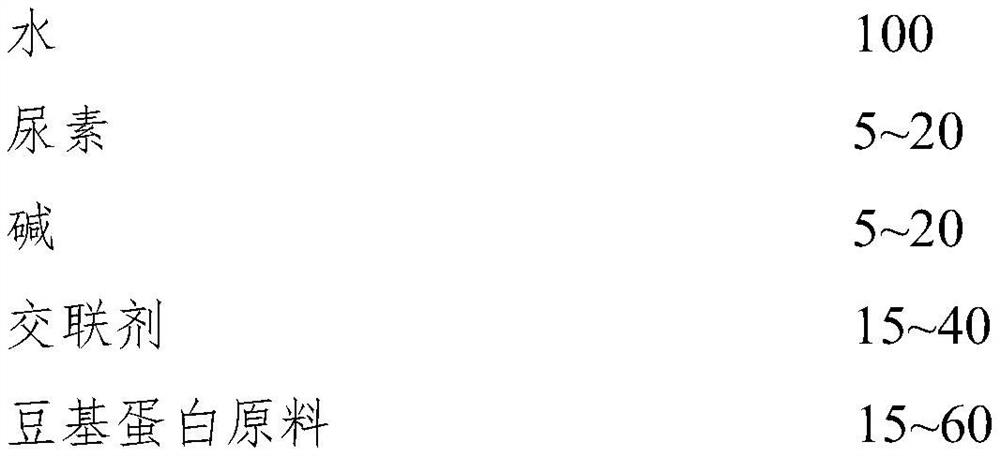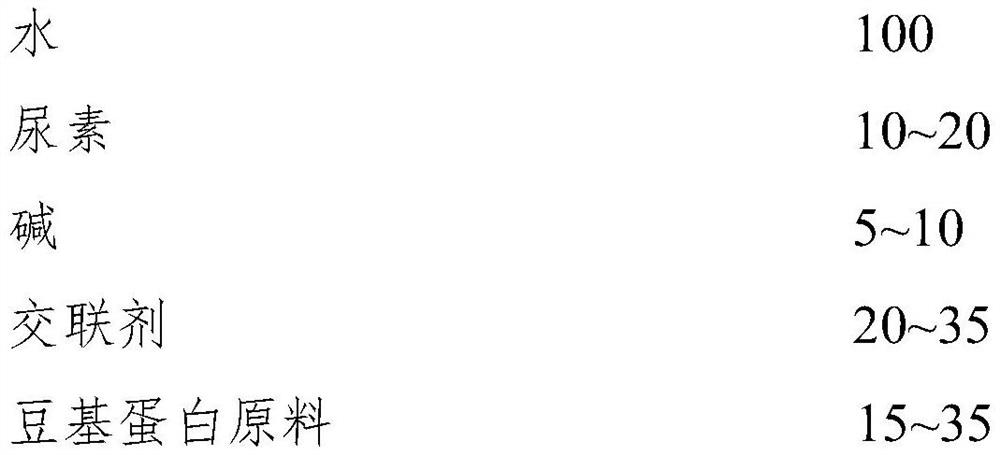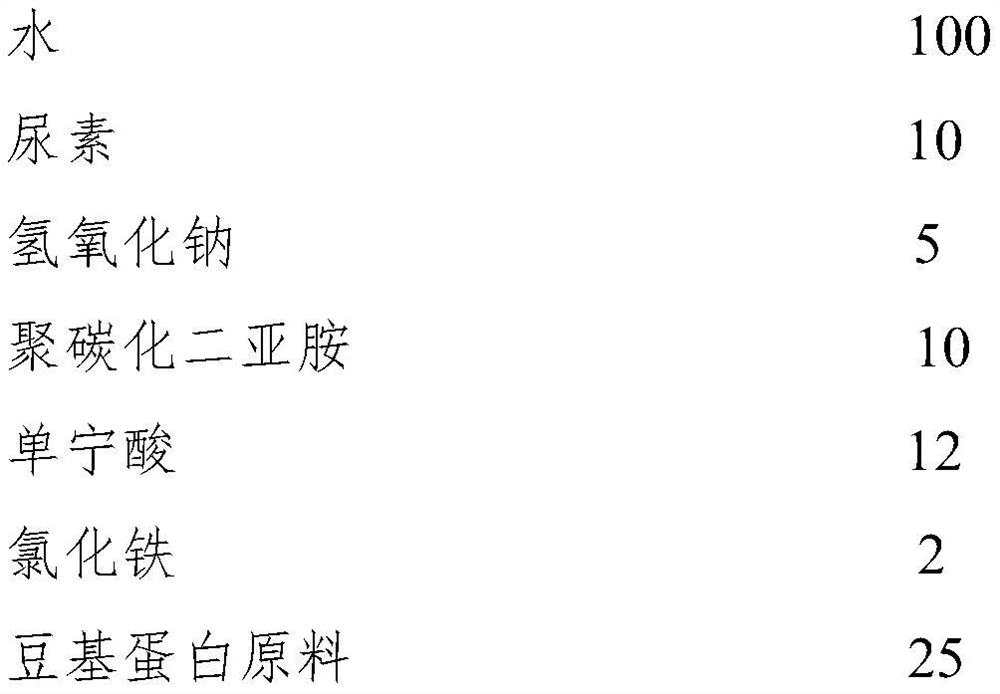Soybean-based protein adhesive for wood-based panels and preparation method thereof
A soy-based protein and protein glue technology, applied in the preparation of protein adhesives, animal glue or gelatin, adhesives, etc., can solve the problems of high toxicity of cross-linking agents, environmental pollution, etc., achieve excellent water resistance, and solve excessive dependence on , The effect of solving resource problems
- Summary
- Abstract
- Description
- Claims
- Application Information
AI Technical Summary
Problems solved by technology
Method used
Image
Examples
Embodiment 1
[0046] 1. Prepare materials according to the following weight ratio (Kg):
[0047]
[0048] 1. Put 10Kg of polycarbodiimide, 12Kg of tannic acid and 2Kg of ferric chloride in a reaction kettle, and stir evenly at 800 rpm to obtain a crosslinking agent for soy-based protein adhesives.
[0049] 2. Disperse 5Kg of sodium hydroxide and 10Kg of urea in water, and stir evenly at a rotating speed of 900 rpm to obtain a mixed solution of sodium hydroxide and urea.
[0050] 3. Disperse the cross-linking agent prepared in step 1 into the above-mentioned mixed solution of sodium hydroxide and urea, and stir evenly at 1000 rpm to obtain a mixed solution of sodium hydroxide and urea dispersed with the cross-linking agent .
[0051] 4. Add the above-mentioned mixed solution of alkali and urea containing a crosslinking agent to 25 kg of soy-based protein raw material at a rotational speed of 1000 rpm, and copolymerize at 60° C. to obtain a soy-based protein adhesive.
[0052] The perfor...
Embodiment 2
[0056] 1. Prepare materials according to the following weight ratio (Kg):
[0057]
[0058]
[0059] 1. Put 12Kg of polycarbodiimide, 12Kg of caffeic acid and 2Kg of sodium periodate in a reaction kettle, and stir evenly at 1000 rpm to obtain a crosslinking agent for soy-based protein adhesives.
[0060] 2. Disperse 10Kg of potassium hydroxide and 15Kg of urea in water, and stir evenly at a rotating speed of 1100 rpm to obtain a mixed solution of potassium hydroxide and urea.
[0061] 3. Disperse the cross-linking agent prepared in step 1 into the above-mentioned mixed solution of potassium hydroxide and urea, and stir evenly at 1000 rpm to obtain a mixed solution of potassium hydroxide and urea dispersed with the cross-linking agent .
[0062]4. Add the above-mentioned mixed solution of alkali and urea containing a crosslinking agent to 20 kg of soy-based protein raw material at a rotational speed of 1200 rpm, and copolymerize at 70° C. to obtain a soy-based protein ad...
Embodiment 3
[0067] 1. Prepare materials according to the following weight ratio (Kg):
[0068]
[0069] 1. Put 10Kg of polycarbodiimide, 10Kg of protocatechuic acid and 3Kg of hydrogen peroxide in a reaction kettle, and stir evenly at 1100 rpm to obtain a crosslinking agent for soy-based protein adhesives.
[0070] 2. Disperse 8Kg of calcium hydroxide and 15Kg of urea in water, and stir evenly at a rotating speed of 1000 rpm to obtain a mixed solution of calcium hydroxide and urea.
[0071] 3. Disperse the cross-linking agent prepared in step 1 into the above-mentioned mixed solution of calcium hydroxide and urea, stir evenly at 900 rpm to obtain a mixed solution of calcium hydroxide and urea dispersed with cross-linking agent .
[0072] 4. Add the mixed solution of alkali and urea containing the cross-linking agent to 20 kg of soy-based protein raw material at a rotational speed of 1000 rpm, and copolymerize at 90° C. to obtain a soy-based protein adhesive.
[0073] The performance ...
PUM
| Property | Measurement | Unit |
|---|---|---|
| viscosity | aaaaa | aaaaa |
| particle size | aaaaa | aaaaa |
| viscosity | aaaaa | aaaaa |
Abstract
Description
Claims
Application Information
 Login to View More
Login to View More - R&D
- Intellectual Property
- Life Sciences
- Materials
- Tech Scout
- Unparalleled Data Quality
- Higher Quality Content
- 60% Fewer Hallucinations
Browse by: Latest US Patents, China's latest patents, Technical Efficacy Thesaurus, Application Domain, Technology Topic, Popular Technical Reports.
© 2025 PatSnap. All rights reserved.Legal|Privacy policy|Modern Slavery Act Transparency Statement|Sitemap|About US| Contact US: help@patsnap.com



